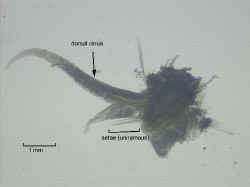 Parapodia and Setae
Parapodia and Setae
Anterior parapodia direct forward and have tapered ventral
cirri. Posterior parapodia are smaller with cushion-like ventral cirri.
Branchiae present and
simple form.
Setae at the first few parapodia include winged
capillaries and pseudocompound form. The posterior parapodia have winged
capillaries, comb-setae and acicular setae.

 The 1st parapodia
The 1st parapodia
(biramous & no branchiae)
